Bonds & Interest Rates
 ….versus the Bernanke “Put”
….versus the Bernanke “Put”
If the Janet Yellen testimony before the Senate Banking Committee this week illustrated anything, it is that the transition from Ben Bernanke to the incoming chair of the US Federal Reserve will be seamless. It is the typical story of the US Federal Reserve being dependent on the data driven recovery of the US economy that will affect their asset tapering decisions. Unfortunately though, it has become a distraction as to shift investor’s concentrations away from the perils of unproductive fiscal policy (at any level of government) and instead focus on the financial markets, which for the sixth consecutive week saw the S&P 500 and Dow Jones trade higher.
The unfortunate realization or perhaps lack of realization is that central banks, led by the US Federal Reserve, will continue to be the only game in town, and that was the message Janet Yellen implicitly provided last Thursday. US economic growth sits at that inflection point of around 2 percent where we will still wait to see whether the economy is ready to reach former Bank of Canada and current Bank of England Governor Mark Carney’s coined term “escape velocity.”
But the biggest reason that the credit easing policies will continue is because of the lackluster inflation levels seen all around the world. Until inflation actually becomes a credible threat to the worlds developed economies, there is no pressure on central banks to begin tightening their policies, or even talk about it. This is especially true given the average inflation rate in the OECD developed countries has fallen from 2.2 percent in 2012 to 1.5 percent so far this year. And reports out of the European Union last week highlight that deflation was more of threat than inflation with October’s inflation numbers registering at .7 percent. That creates a major threat to the nations of Europe, where the risk of seeing prices decline will create yet another impediment to their recovery from a triple dip recession.
The other issue, however, with forecasted paltry inflation levels is what countries with low inflation are associated with, and that is persisting levels of high jobless rates and mediocre growth. For this reason alone, the world’s central banks continue their aggressive policies, but it does truly illustrate their positions between a rock and a hard place as any opportunity to spur or revitalize economic growth is jeopardized by an unwavering price level. As Mohammad El-Erian argues, central bankers in today’s world are only destined to fail because our expectations for what they can deliver is far too inconceivable, given the “the much-sought-after trifecta of greater financial stability, faster economic growth, and more buoyant job creation.”
So it is not so much that there is a responsibility among the central bankers to instill the prior mentioned trifecta of economic goals, it is rather the shortfall of elected policy makers that force us to rely on the independent institution of a central bank. And just as it was the “Greenspan Put” beginning in the early 2000’s that saw the Federal Funds Rate drop every time the economy hit a speed bump to the “Bernanke Put,” which commenced the greatest era of manipulation of the Federal Reserve’s balance sheet in order to stimulate the economy, investors now eagerly await what will be the “Yellen Put.” Whether its offered forward guidance of low interest rates into the unknown future, or perhaps quantitative easing continuing longer than anticipated, one thing is certain, and that is for this economic recovery to continue central bankers are still needed more desperately than ever.
More Articles from Robert Levy HERE


The Death of Government & our free lunch mentality is 1/2 of the equation. The other 1/2 is the rise of the Private Sector, New Technologies, Innovations & their impact on our lives. It also means change as last week BlockBuster closed its last 300 stores. In the meantime their are exploding companies & industries like Netflix, Facebook while we are on the brink of 3D Printing of Human Organs & food. More below:
{mp3}mtnov16lead2fp{/mp3}
The second hour of Money Talks begins with Michael interviewing Peter Grandich!! Though he never finished high school, Peter Grandich entered Wall Street in the mid-1980s with no formal education or training and within three years was appointed Vice President of Investment Strategy for a leading New York Stock Exchange member firm. He would go on to hold positions as a Market Strategist, portfolio manager for four hedgefunds and a mutual fund that bore his name. Now Peter comments on Markets soley for Money Talks and are we ever glad to have his perspective illustrated in this interview below.
{mp3}mtnov913hourfp{/mp3}

 U.S. stock market gauges racked up a sixth-straight weekly gain. The S&P 500 and Dow Jones Industrial Average again hit record closes today.
U.S. stock market gauges racked up a sixth-straight weekly gain. The S&P 500 and Dow Jones Industrial Average again hit record closes today.- This week Wal-Mart (WMT) reported third-quarter earnings slightly higher than analysts expected. The stock fell, though, because the company reduced its full-year profit forecast. In other words, Wal-Mart doesn’t expect a great holiday shopping season.
- Janet Yellen’s testimony signaled to Wall Street the Fed would not close the QE faucet just yet. That means a giant green light for equities.
- Moody’s downgraded senior debt ratings on four top bank holding companies including Goldman Sachs (GS) and JPMorgan Chase (JPM).
 Explaining its decision, Moody’s thinks the regulatory environment now indicates the banks are less-likely to receive government bailouts in a crisis — and leave bondholders with higher risk.
Explaining its decision, Moody’s thinks the regulatory environment now indicates the banks are less-likely to receive government bailouts in a crisis — and leave bondholders with higher risk.- Government-sponsored mortgage giants Fannie Mae and Freddie Mac surged after hedge funds disclosed new ownership stakes.
- Futures exchange operator CME Group (CME) said hackers breached its systems in July and compromised customer information.
- CME said there is no evidence the hackers influenced trading activity, but did not rule out the possibility.
- Microsoft is aiming the Xbox One at a broader market. It is primarily a gaming device, but the company is also pitching it as a primary living room device for watching movies, exercising with motion sensors, and video chatting with friends over Skype (which Microsoft owns).

 My “Peter Lynch Moment” Just Served a Huge Buy SignaL
My “Peter Lynch Moment” Just Served a Huge Buy SignaL
Mutual fund superstar Peter Lynch used to say that individual investors had a big advantage over Wall Street. If you just keep your eyes and ears open, Lynch would write, you’re bound to see big profit opportunities long before the investment-banking boys in New York.
And the biggest opportunities are often right in your own neighborhood.
Lynch knew his business.
For months now, we’ve been talking about a “ground floor” investing opportunity – a whole new business that I believe could triple or more in the next few years.
Well, just the other night, as my lovely wife and I were strolling to a village restaurant near our home, I ran right into proof that this potential $6 billion industry has already grabbed a big handful of the all-important consumer market.
This was more than just validation: It tells me this market is evolving even faster than I projected – and says I may have underestimated the overall market potential.
And that’s not all…
….read the rest HERE (Ed Note: Be sure to read the last half of “Shaking Up Silicon Valley” )

Special Report: Why the Meltdown in Copper Prices this Week is Very Important for Precious Metals, and Possibly Equities Markets
The technical breakdown in Comex copper futures this week is not only an ominous clue for the red metal, but it’s also a bearish signal for the entire raw commodity sector. December Comex copper futures prices this week dropped sharply and hit a three-month low. A bearish downside technical “breakout” occurred on the daily chart for the copper futures market, to suggest still more downside price pressure in the near term.
See on the monthly continuation chart for nearby Comex copper futures that prices have been trending lower for nearly three years and are on the verge of a downside breakout below key longer-term chart support at the $3.00 level.
Copper is a critical industrial metal used in construction worldwide. The fact copper prices dropped sharply this week is an early warning signal that construction activity worldwide could be flagging.
Indeed, history also shows copper market price moves can lead similar moves in the U.S. stock indexes. Along with the recent solid price downtrend in Nymex crude oil futures, the copper market meltdown this week suggests the raw commodity sector, in general, remains firmly controlled by the bears.
Importantly, the price action in copper and crude oil recently also corroborates the growing worries of worldwide deflationary price pressures.
Veteran commodity market watchers know that deflation is the archenemy of commodity markets.

Follow me on Twitter to immediately get the very latest market developments. If you are not on board, then you are not getting key analysis and perspective as fast or as often as you could! Follow me on Twitter to get my very timely intra-day and after-hours briefs on precious metals price action. The precious markets will remain very active. If you want market analysis fast, and in after-hours trading,then follow my up-to-the-second precious metals market perspective on Twitter. It’s free, too. My account is @jimwyckoff.
By Jim Wyckoff, contributing to Kitco News; jwyckoff@kitco.com











